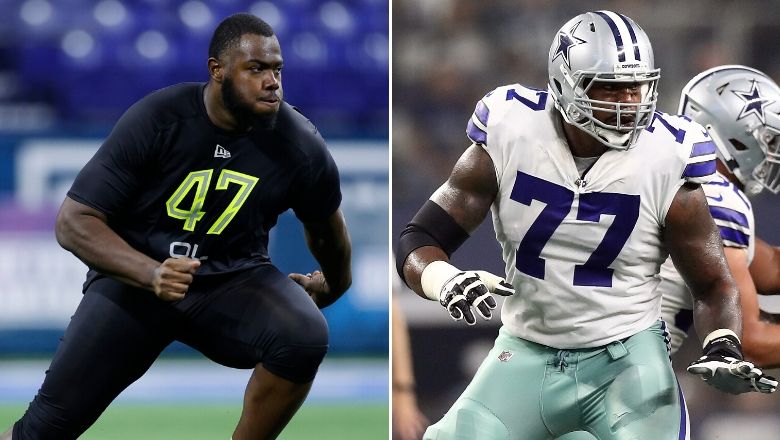
Getty Giants' Andrew Thomas (L) & Cowboys' Tyron Smith (R)
The New York Giants believe they’ve found an anchor for their offensive line for the next decade in 4th-overall draft pick Andrew Thomas. The only question now is, where will they drop that anchor in his rookie season?
Follow the Heavy on Giants Facebook page for all the latest stories, rumors and viral content!
Jason Garrett’s History With Stud Offensive Tackles
If new offensive coordinator Jason Garrett has his way, and history repeats itself, then Thomas’ initial taste of the NFL may very well come from the right tackle position.
In a recent breakdown of the Giants’ position decision with Thomas, The Athletic’s Dan Duggan pointed towards Dallas Cowboys’ 2011 1st-round draft pick, Tyron Smith, as a potential blueprint that the ex-Georgia standout could follow.
When Garrett, Dallas’ head coach at the time, selected Smith out of USC in 2011, the team had a somewhat established left tackle in place in veteran Doug Free. Similar to that of the Giants’ current situation with Nate Solder.
Garrett and the Cowboys opted to keep Free on the left side, placing Smith at right tackle for his rookie season. Smith’s tenure on the right side lasted just one season, he flipped to left tackle the following year, and has remained at the position ever since, collecting seven Pro Bowls in the midst.
History of Top-10 Tackles Playing on the Right Side
The idea of using an early 1st-round pick on a tackle, starting him on the right side, and then eventually transitioning him to the left is a highly tossed around approach during draft season. Yet, it’s rarely a scenario put into motion once said player is brought aboard. Only three tackles picked in the top-10 over the past 10 seasons have played right tackle as rookies before shifting to left tackle.
Future Hall of Famer Joe Thomas recently weighed in on the Giants’ current tackle situation, pointing towards New York’s feelings towards Nate Solder, not Thomas, as being the main caveat behind their eventual decision.
“If you’re saying, ‘These two guys are going to be here for the next four years,’ I think it would make more sense to put Andrew Thomas at right tackle because he’s younger, he has fewer reps under his belt and the muscle memory is easier to change,” Joe Thomas said. “I would assume if this is Nate’s last year, put him at right tackle and let Andrew start at left because that’s where he was last year, he’s gotten more reps there, he’s going to have a head start at that position. I think as a rookie, especially without an offseason due to the coronavirus, playing a position that you have more experience, especially recent experience, is going to be beneficial.”
Thomas’ Positional Flexibility Bodes Well for Giants’ Future
Nate Solder has not performed up to his massive $62 million contract Dave Gettleman handed to him in 2018. As of now, the idea of creating $14 million in cap space by cutting Solder next offseason sounds almost like a certainty, rather than a possibility. However, the addition of Thomas and 3rd-round selection Matt Peart could certainly light a fire up under the 2x-Super Bowl champ.
Speaking of Peart, many have pegged the former UConn Husky’s more natural position to be left tackle. Senior Bowl executive director and ex-NFL scout Jim Nagy even went as far as to say that if “where they got drafted from wasn’t an issue, you’d probably put Peart at left and Thomas on the right.“
Thomas, who has history playing both tackle positions during his collegiate days, has been learning both the left and right tackle spot with the G-Men during the team’s virtual offseason meetings.
Thomas’ former positional coach at Georgia, Sam Pittman, isn’t the least concerned about where New York decides to line up his former star player. Either way, Pittman envisions Thomas excelling for Big Blue.
“He can play either side and it won’t be any problem,” Pittman said. “He’s very good with his feet and he’s really bright. It’s how fast he processes the looks. A lot of guys can see what’s getting ready to happen in the film room and then they’re still behind on the play. He wasn’t that way. Once he recognized what his eyes saw, he could process it really fast. He’s one of the smartest players I’ve ever coached.”
READ NEXT:
- Tiki Barber Snubs Saquon Barkley in Choice of Top NFL RBs [WATCH]
- Ex-Giants QB Raves About ‘Phenomenal’ Jones, Garrett Tandem
- Giants’ Daniel Jones Has Gained Some Serious Weight This Offseason
- Giants’ Saquon Barkley Excluded From List of NFL’s Best Players
- Giants ‘Surprise Rookie Gem’ Compared to Super Bowl Champ
